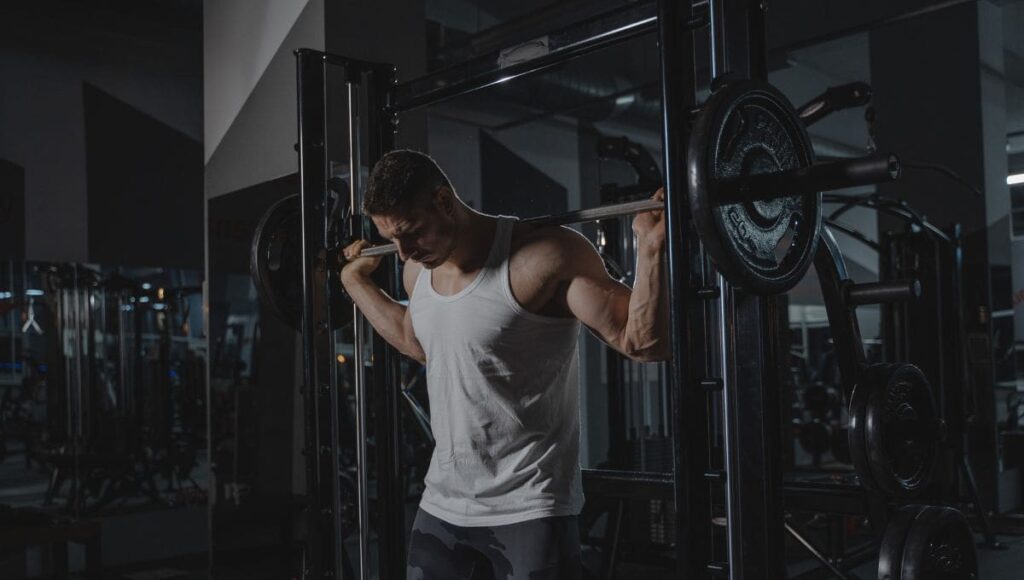Lower body training is a cornerstone of athletic performance, functional fitness, and muscular development. However, not all exercises are created equal.
While some movements deliver exceptional benefits, others are inefficient, ineffective, or even potentially harmful. This article highlights three lower body exercises you should avoid and explains why they don’t deserve a spot in your training routine.
1. Smith Machine Squats
The Smith machine squat is a popular lower body exercise, particularly among gym newcomers. The fixed bar path in the Smith machine seems appealing for beginners as it eliminates the need for balance. However, this convenience often comes at the cost of long-term muscle development, functional strength, and joint health.
 Source: Tima Miroshnichenko / Pexels
Source: Tima Miroshnichenko / PexelsWhy Smith Machine Squats Are Ineffective
1. Lack of Functional Movement: Research demonstrates that free-weight squats recruit more stabilising muscles compared to Smith machine squats due to the need for balance and coordination (Schwanbeck et al., 2009). The fixed path limits natural movement patterns, potentially increasing the risk of joint stress.
2. Reduced Muscle Activation: Studies indicate that the Smith machine squat elicits lower activation in key muscle groups such as the glutes, hamstrings, and spinal stabilisers compared to barbell squats (Anderson & Behm, 2005). This can lead to an imbalanced lower body over time.
3. Potential Joint Stress: The machine enforces an unnatural movement trajectory, which can lead to knee and lower back discomfort for many individuals, particularly when heavy loads are used (Escamilla, 2001).
Better Alternative: Barbell Back Squat
The barbell back squat allows for a full range of motion and engages multiple muscle groups while promoting balance and coordination. It’s also more effective at building functional strength, as confirmed by numerous studies.
2. Leg Extensions
The leg extension is often marketed as a targeted isolation exercise for the quadriceps. However, despite its popularity in commercial gyms, this exercise has significant drawbacks that make it less than ideal for most trainees.

Why Leg Extensions Are Inefficient
1. Overload on the Knees: Research has shown that leg extensions place excessive shear forces on the knee joint, particularly the anterior cruciate ligament (ACL) (Rojas et al., 2013). This can increase the risk of injury over time, especially for those with existing knee issues.
2. Poor Functional Carryover: The leg extension isolates the quadriceps without engaging stabilising muscles or replicating real-world movement patterns. Functional lower body exercises like squats and lunges activate the quadriceps alongside other muscles, improving overall athletic performance (Escamilla et al., 2009).
3. Limited Muscle Engagement: While the quadriceps are targeted, the hamstrings, glutes, and other stabilising muscles are neglected. This imbalance can lead to weaker posterior chain development, which is crucial for overall lower body strength.
Better Alternative: Bulgarian Split Squat
The Bulgarian split squat is a unilateral exercise that targets the quadriceps while engaging the glutes, hamstrings, and core. It promotes balance, functional strength, and muscular symmetry.
3. Seated Hip Abduction Machine
The seated hip abduction machine is often used to “tone” the outer thighs and glutes. While it provides some activation in the gluteus medius and minimus, its effectiveness is minimal compared to other glute exercises.
Why Seated Hip Abduction is Ineffective
1. Minimal Functional Benefits: The movement performed on the machine has little to no carryover to real-world activities. Functional exercises like hip thrusts or lateral band walks activate the same muscles in a way that translates better to athletic and daily movements (Contreras et al., 2011).
2. Reduced Muscle Activation: Electromyography (EMG) studies have shown that exercises like the hip thrust or step-ups produce significantly higher activation in the gluteal muscles than the seated hip abduction machine (McCurdy et al., 2010).
3. Poor Postural Engagement: The seated position of the machine reduces the involvement of the core and other stabilising muscles, making it a less effective choice for overall lower body training.
Better Alternative: Hip Thrusts
Hip thrusts are a superior exercise for targeting the glute muscles. They offer a full range of motion and engage the posterior chain, core, and stabilising muscles effectively.
Conclusion
While these three exercises are not entirely useless in every scenario, their inefficiency, potential for injury, and lack of functional carryover make them poor choices for most training programmes. By focusing on compound, functional movements, you can optimise your lower body workouts and achieve better results.
Bibliography
Anderson, K. and Behm, D.G., 2005. Trunk muscle activity and lumbo-pelvic stability during exercises performed on stable and unstable surfaces. Journal of Strength and Conditioning Research, 19(4), pp.716-723.
Contreras, B., Schoenfeld, B.J., Beardsley, C., et al., 2011. Gluteal muscle activation during common strength training exercises. Journal of Applied Biomechanics, 27(3), pp.209-217.
Escamilla, R.F., 2001. Knee biomechanics of the dynamic squat exercise. Medicine and Science in Sports and Exercise, 33(1), pp.127-141.
McCurdy, K., Langford, G., Doscher, M., et al., 2010. The effects of exercise selection on gluteal muscle activation during weight training. Journal of Strength and Conditioning Research, 24(1), pp.1-5.
Rojas, I.L., Zafra, M., Martínez, G., et al., 2013. ACL injury risk factors: a review of the literature. International Journal of Sports Medicine, 34(3), pp.225-230.
Schwanbeck, S., Chilibeck, P.D., and Binsted, G., 2009. A comparison of free weight squat to Smith machine squat using electromyography. Journal of Strength and Conditioning Research, 23(9), pp.2588-2591.
Key Takeaways Table
| Key Takeaway | Reason | Better Alternative |
|---|---|---|
| Avoid Smith Machine Squats | Fixed bar path limits functional movement and increases joint stress. | Barbell Back Squats |
| Skip Leg Extensions | Excessive knee stress and poor functional carryover. | Bulgarian Split Squats |
| Stop Using the Seated Hip Abduction Machine | Minimal functional benefits and reduced muscle activation. | Hip Thrusts |


